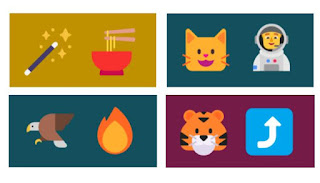Students Respond to Changes in the Library - Genre-fication
I made two changes to our library program and introduced these to 2nd-5th grade students on our first day of library.
I had made an effort to put interesting books into bins and label them accordingly so certain series would be easily identifiable but my concern was for the students who wanted a book like something else they had read.
Diary of a Wimpy Kid fans knew where the "Wimpy Kid shelf" was, but did they know how to find other books like them that they might enjoy?
My categories for books reflected the kind of requests I have been fielding for years:
Humor
Animal
Sports
Realistic Fiction
Adventure
Mystery
Classics
Fantasy
Science Fiction
Scary/Unexplained
Students immediately embraced the change and showed me their favorite section with their choices:
I was interested to know their initial thoughts on the changes and asked them to respond.
1. Genre-fication of the fiction section
In the past I found myself moving shelf to shelf with children pulling out the "funny" books or the "animal" books to show them their options. While I was more than happy to do this, I felt that I was not building capacity in students. I showed students how to locate books in the catalog, but if they only had a few minutes to locate a book and they weren't exactly sure what they wanted, our collection wasn't all that browseable.I had made an effort to put interesting books into bins and label them accordingly so certain series would be easily identifiable but my concern was for the students who wanted a book like something else they had read.
Diary of a Wimpy Kid fans knew where the "Wimpy Kid shelf" was, but did they know how to find other books like them that they might enjoy?
My categories for books reflected the kind of requests I have been fielding for years:
Humor
Animal
Sports
Realistic Fiction
Adventure
Mystery
Classics
Fantasy
Science Fiction
Scary/Unexplained
Students immediately embraced the change and showed me their favorite section with their choices:
 |
| After Studen |
 |
| Before Students |
2. Flexible checkout
I typically have students check out 2 books at a time but wondered what would happen if I made book checkout more flexible. Would they read more? Would this generate more excitement about reading? As a voracious reader I always have a giant TBR pile. Would this help my students to do the same and practice these skills that "good readers" have? I decided to let them take between 1 and 5 books each week (requiring them to pick at least 1 book and browse our shelves).The Benefits
- Students' excitement was escalated. They were thrilled to be able to take "more." (More is ALWAYS better in their eyes).
- Students compared book piles.
- Students planned which book they would read first, next, and so on.
The Issues
- Students selected books just to "have" them. 5 giant chapter books for a struggling 2nd grade reader? These are not books to be read, rather trophies to carry around.
- Students wiped us out of series by taking 5 titles of the same series. Now there was nothing left for the next child.
- Students return all 5 "trophy books" the following week (there is no way they could have read them) and immediately select 5 more in the same manner.
What I did
- While my initial reaction was to backpedal and go back to our old ways, I decided to stick it out and use this as a teachable moment.
- Conversation - I used these examples of what I saw to start a conversation with students. Is it fair if one or two students have all of the books in a series? Does it make sense to choose a giant pile of chapter books when you know that you just won't get to all of them this week?
- We talked about what good readers do - assess their reading needs and choose accordingly. "Hmm. I am already reading a chapter book in school and one at home. I think I am going to choose some shorter or more browseable books. Maybe some "everybody" books and some nonfiction would be best for me this week."
- We talked about sharing with our fellow students and limiting checkout of series books to 2 books in a series.
I was interested to know their initial thoughts on the changes and asked them to respond.
I will reassess as I go this year. I am curious to see what this does to circulation statistics. I am curious to see how much traffic I get in the morning (I encourage teachers to send students to me at the beginning of the day to get new books). Will this encourage students to select more books? Read more books? Be more engaged in their reading? I will follow this up with a survey of students' opinions on reading and see if I can get a clearer picture of what impact this will have (if any) on their reading lives.





Comments
Post a Comment